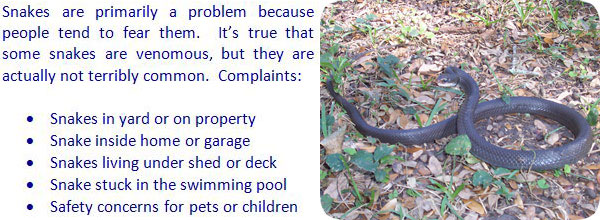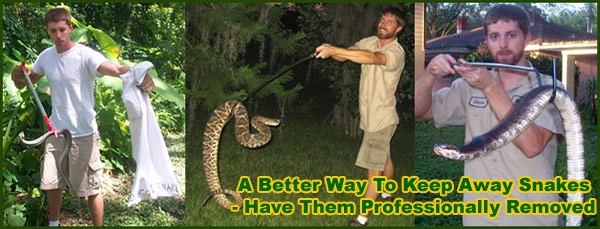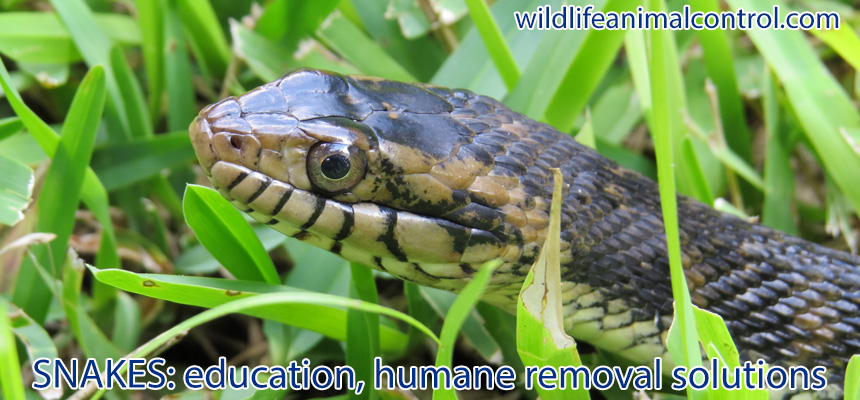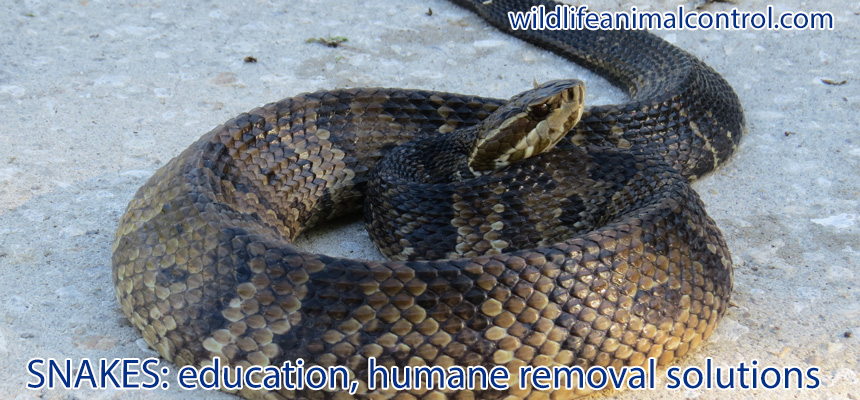- info@wildlifeanimalcontrol.com
Call us for help in your town
Wildlife Control Education
How to Get Rid of Snakes

We provide snake removal in over 1700 USA locations - serving the whole USA.
It is my goal to educate the public about snakes and other wildlife, and
provide tips for safe, effective, and responsible wildlife removal.
Need snake removal in your hometown? We service over 500 USA locations! Click here to hire us in your town and check prices - updated for year 2020.
Snakes are one of the most feared reptiles on the planet and the funny thing is that only a handful of them are poisonous. There are so many different species of snakes, but they all have long cylindrical bodies that have no legs and a head. Snakes are almost pure muscle and this is how they can move/slither over all kinds of terrain. The pattern and colors of their scales and the shape of their head are dependent on the species of snake. While snakes are actually good to have around because they eat the bugs that can destroy crops and gardens, you definitely do not want a poisonous or a nuisance snake lurking around your house.

Snakes usually do not cause any damage to your home or your garden, but the mere presence of them can be a nuisance to you, your children or your pets. Snakes are good critters to have around because their diet consists of worms, insects and birds that can actually cause more damage to your plants than the snake will. However, if a snake has set up shop under your house or your porch, they will reproduce and then you can have a real problem. When there is more than 100 snakes roaming around your home (and in your home) you are going to want to control it. If you have a snake infestation or have noticed a poisonous snake on your property, you will want to remove it immediately before it becomes a problem or someone gets bitten. Here are a few suggestions you can try:
- Call a professional pest removal service if you have a major snake infestation or a poisonous snake problem. They will know how to properly relocate the snake in a way that is safe for you and the snake. Just because they are venomous or scare us, doesn't give us the right to kill them. The professional removal expert will also be able to identify why and where the snakes are getting into your house/property.
- Keep your lawn cut short and put a fence around your garden. If you don't want snakes to be attracted to your garden, you need to build a fence around it (a tight wire mesh fence works best) to keep the snake out. Also, keep your grass cut short so the snake doesn't have anywhere to hide or keep cool in the heat of the day. Make sure that the bushes and shrubs around your house are trimmed too because these are favorite snoozing spots for snakes. Information about how to keep snakes away - prevention techniques.
- There are many repellent products out there for snakes, but the problem is that most of them don't work. The ones that do work, like predator scents of mongoose and king snake musk, only work for a short time and you are going to be spending more money than is worth it. Only use repellents along with other methods of snake control. Information about snake repellent - analysis of types and effectiveness.
- There are also snake traps that work pretty well. You can buy these online, in some hardware stores or you may want to call a local animal control office to see if they will loan you one. These will only work for a little while as the snake will learn not to go in there. Information about snake trapping - analysis and methods for how to trap.
- This method should only be used with non-venomous snakes! Snakes are afraid of animals and humans. If you keep your dogs and cats outside there is a good chance that snakes will stay away. Dogs have been known to kill snakes that come around. If you should see a non-venomous snake you can make lots of noise and run at it and it will run away and not come make. They are very sensitive to noises, movement and vibrations in the ground.

More in-detail how-to snake removal articles:
Information about how to kill a snake - with shovel, gun, or poison.
Information about how to catch a snake - remove one stuck in the house.
Snake Information & Facts
Snake Appearance: Snakes are legless reptiles covered in a pattern of overlapping scales. True snakes have no external ears and no moveable eyelids. Colors vary from muted earth tones to vibrant patterns. Most snakes have triangular heads outfitted with flexible jaws which allow consumption of larger prey. Serpents have the widest size variability of all vertebrates, ranging from a few inches in length to almost fifty feet long. The long, tube-like body of this animal does not allow for much room internally, so any dual organs are located behind one another rather than side-by-side. Snakes have scales, and these scales facilitate movement along vertical and horizontal surfaces. On occasion, the surface layer of scales sloughs off to allow regeneration of damaged or worn areas. The change of skin also helps defend against external parasites.
Snake Habitat and Behavior: These reptiles are widespread and will survive in almost any climate. The exception to this broad habitation is areas where freezing temperatures persist for the majority of the year. Each subspecies of snake is adapted to live in the regions they are located. Snakes native to sandy areas where no solid surface can provide support have adapted a sideways style of movement. Animals in terrain with dense vegetation will move by way of the traditional back and forth forward slither called lateral undulation. Snakes found in areas with a high percentage of water are well adapted to swimming.
Just as habitat varies by subspecies, so too do most behavioral aspects of serpents. Egg laying is typical for snakes, and the duration of time spent with the eggs depends on the subspecies involved. Larger snakes may give birth to live young, though this is the exception and not the rule.
All snakes can be classified in the groups of venomous and nonvenomous. Nonvenomous snakes can and will bite, and those injuries can be serious but rarely fatal. Venomous snakes are not overtly aggressive, using their venom to subdue prey rather than attack unwary passersby.

Snake Diet: All snakes are carnivores. Their diet consists of vertebrates and eggs, with insects and other invertebrates making up a percentage of the diet. The size of the snake is directly proportional to the size of game it will attempt to prey on. Serpents swallow prey whole, using their flexible lower jaw to pass the food into the stomach. Larger snakes will compress sizeable prey within their coils, killing the food animal and breaking the bones.
Snake Nuisance Concerns: Snakes are naturally drawn to areas around human dwellings for various reasons. An unkempt home may have long grass full of insects and many tempting locations for a snake hole. Poor home upkeep will also lead to an increase in rodents, another main food source for many snakes. It is rare for snakes to appear in numbers, but an ideal spot can draw a handful of the serpents in. Many snakes are also drawn to pools. The reptiles will bask on the pool rim and use the pool as a source of hydration. A few, unlucky snakes will attempt to swim in the water and may find that they are unable to climb back out. Most people are fearful of snakes around the home due to the general inability to discern if they are poisonous or not.
Snake Diseases: The most well-known diseases associated with snakes are E.coli and salmonella poisoning. A variety of other, less known diseases can also be of concern. These illnesses include aeromonus hydrophila, Q fever, proteus vulgaris, and mycobacterium ulcerans. Although not a disease, the most common ailment humans obtain from serpents is poisoning from a venomous snake bite. While most venom worldwide is a neurotoxin and can disable a healthy human in less than fifteen minutes, most snake venoms in North America are cytotoxic, (kind of like hemotoxic) venoms, which attach tissues and blood cells. All the pit vipers, which make up the majority of venomous snakes in North America - rattlesnakes and copperheads and cottonmouths - have this type of venom. Neurotoxic venom, which attacks the nervous system, is rare in American snakes - only the Coral Snakes have it.
You are here to learn how to get rid of snakes in the house or yard. This site is intended to provide snake education and information, so that you can make an informed decision
if you need to deal with a snake problem. This site provides many snake control articles and strategies, if
you wish to attempt to solve the problem yourself. If you are unable to do so, which is likely with many
cases of snake removal, please go to the home page and click the USA map, where I have wildlife removal experts
listed in over 500 cites and towns, who can properly help you with your nuisance snake.
Other snake educational topics:
Find out more in our educational articles about snakes. Learn more about various species of snakes, including The Yellow Rat Snake, The Water Moccasin Snake, and
The Black Racer Snake - as well as lists of Venomous snakes of Florida as well as Types of Florida Water Snakes. Our articles can also help answer questions about ways to kill a snake in the yard, whether or not snakes can climb stairs or a wall, what to do if you find a shed snake skin, as well as Where to relocate a trapped snake, if a rope will act as a snake repellent, and whether or not a snake under a porch or shed will have a nest of babies.
Read more information in my articles written to help you with your snake probelm. Learn how to find and remove snakes in your attic and what to do if you are bitten by a snake. Read more about whether or not snakes have bones, what snake feces look like and where to find them, snake mating habits, and if snakes lay eggs. I also have collected information about some commonly found snakes so readers can be more familiar with the individual species - like the Banded Water Snake, the Black Rat Snake, as well as the Brown Water Snake. Learn what to do with a snake after you catch it, and about the Deadliest Snake in the United States. Read how to get snakes out from under a shed or porch and if snakes make good pets. Learn about the Copperhead Snake, the Coral Snake, the Corn Snake, and be sure to memorize the most important rhyme you'll ever need to know: “Red touch yeller kill a feller, red touch black is a friend to Jack".
Read more to find out if a pest control company will remove a snake, and what to do if you find a nest of snakes. Learn all about the Northern Water Snake and how to find a snake in your house. Learn what animals catch and kill snakes and if the city or county animal services will help with a snake issue. Find out if snakes have ears, how to keep snakes out of the garden, and if a high pitch sound deterrent machine will work against snakes. Read about Garter Snakes and the problem of Burmese Pythons in south Florida.

















